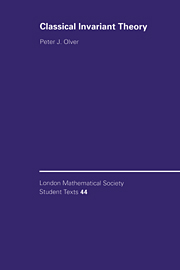Book contents
- Frontmatter
- Contents
- Introduction
- 1 Prelude — Quadratic Polynomials and Quadratic Forms
- 2 Basic Invariant Theory for Binary Forms
- 3 Groups and Transformations
- 4 Representations and Invariants
- 5 Transvectants
- 6 Symbolic Methods
- 7 Graphical Methods
- 8 Lie Groups and Moving Frames
- 9 Infinitesimal Methods
- 10 Multivariate Polynomials
- References
- Author Index
- Subiect Index
5 - Transvectants
Published online by Cambridge University Press: 08 January 2010
- Frontmatter
- Contents
- Introduction
- 1 Prelude — Quadratic Polynomials and Quadratic Forms
- 2 Basic Invariant Theory for Binary Forms
- 3 Groups and Transformations
- 4 Representations and Invariants
- 5 Transvectants
- 6 Symbolic Methods
- 7 Graphical Methods
- 8 Lie Groups and Moving Frames
- 9 Infinitesimal Methods
- 10 Multivariate Polynomials
- References
- Author Index
- Subiect Index
Summary
Of all the available methods for computing invariants and covariants, the most incisive are those based on certain invariant differential operators. The Hessian of a binary form, and the Jacobian of a pair of forms, are just special cases of a general method of constructing covariants known as “transvection”. Not only does this process provide another method for constructing explicit covariants and invariants, but, in fact, every covariant and invariant of any system of binary forms arises using these fundamental operations. These ideas have their origins in Cayley's old theory of “hyperdeterminants”, and culminated in their general formulation by the German school of invariant theorists led by Aronhold, Clebsch, and Gordan. The transvection process is fundamental in the implementation of Gordan's algorithm, for constructing a complete system of independent covariants.
In our presentation, we shall concentrate on the formulation of transvectants based on invariant differential operators or “invariant processes” rather than the more traditional symbolic approach. This point of view has several advantages. First, the formulae for the transvection processes are explicitly given in terms of derivatives of the polynomials, rather than the more shadowy “umbral” or symbolic form. As such, one can immediately apply such invariant processes to more general functions and thereby simultaneously implement an “invariant theory of smooth or analytic functions” without additional work. In fact, the homogeneous polynomials will be seen to play a somewhat anomalous, and computationally more difficult, role in the general theory. Second, the use of differential operators makes clear the fascinating and mostly unexplored connections between classical invariant theory and a wide variety of recent developments in mathematics and mathematical physics, including solitons and integrable systems…
- Type
- Chapter
- Information
- Classical Invariant Theory , pp. 86 - 98Publisher: Cambridge University PressPrint publication year: 1999

